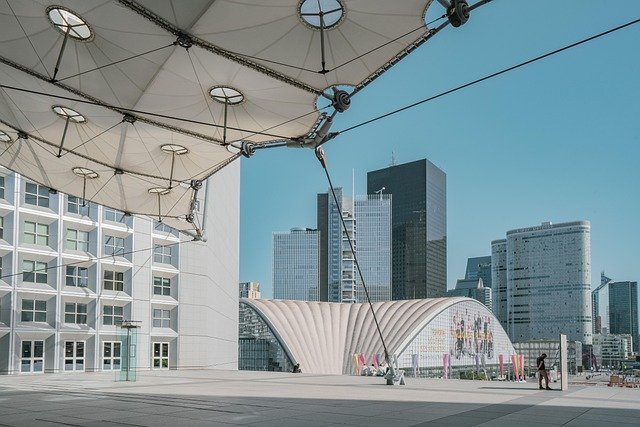The Enigma of Ephemeral Architecture
In a world dominated by towering skyscrapers and enduring monuments, a captivating trend is quietly reshaping our perception of architectural design. Ephemeral architecture, with its fleeting existence and transient beauty, challenges conventional notions of permanence and durability. This article delves into the fascinating realm of temporary structures, exploring their cultural significance, environmental impact, and the innovative minds behind these short-lived marvels.

The philosophy behind this architectural approach aligns with ancient wisdom found in various cultures. From Japanese wabi-sabi, which finds beauty in imperfection and impermanence, to the Buddhist concept of anicca, emphasizing the transient nature of all things, ephemeral architecture resonates with deep-rooted human understanding of life’s fleeting nature.
A Brief History of Temporary Structures
While ephemeral architecture may seem like a modern concept, its roots trace back centuries. Nomadic cultures have long utilized temporary dwellings, adapting to changing environments and seasons. The tradition of creating temporary structures for festivals and celebrations is equally ancient, with examples found in cultures worldwide.
In more recent history, world fairs and expositions became breeding grounds for innovative temporary architecture. The Crystal Palace, built for the Great Exhibition of 1851 in London, stands as a prime example. Although initially intended as a temporary structure, its popularity led to its preservation for several decades before its eventual destruction by fire.
The 20th century saw a surge in interest in ephemeral architecture, particularly in the post-war era. Architects and artists began experimenting with inflatable structures, modular designs, and other forms of temporary installations, pushing the boundaries of what architecture could be.
Contemporary Expressions and Innovations
Today, ephemeral architecture manifests in diverse forms across the globe. From the burning effigy at Nevada’s Burning Man festival to sophisticated pavilions at the Venice Biennale, temporary structures continue to captivate and inspire.
One notable trend is the use of sustainable and recyclable materials. Architects are increasingly turning to biodegradable substances, recycled plastics, and even living materials like mycelium to create structures that leave minimal environmental impact. This approach not only addresses concerns about waste but also sparks conversations about sustainability in the broader architectural field.
Digital technologies have also revolutionized ephemeral architecture. Augmented reality (AR) and projection mapping allow for the creation of virtual structures and immersive environments that exist only in the digital realm or as overlays on physical spaces. These technologies blur the lines between the tangible and intangible, offering new possibilities for architectural expression.
The Cultural Impact of Temporary Spaces
Ephemeral architecture plays a significant role in shaping cultural experiences and public spaces. Temporary installations in urban environments can transform mundane areas into vibrant community hubs, encouraging social interaction and reimagining city landscapes.
Festivals and events heavily rely on ephemeral structures to create immersive experiences. From music festivals like Coachella to art events like Sculpture by the Sea in Australia, temporary constructions set the stage for cultural gatherings, often becoming iconic symbols of the events themselves.
Moreover, ephemeral architecture serves as a platform for experimental design and social commentary. Architects and artists use these temporary spaces to address pressing issues, provoke thought, and challenge societal norms. The freedom afforded by their temporary nature allows for bold statements and innovative concepts that might be too risky or impractical for permanent structures.
Challenges and Criticisms
Despite its growing popularity, ephemeral architecture faces several challenges and criticisms. One primary concern is the environmental impact of creating structures with such short lifespans. Critics argue that the resources and energy invested in these temporary buildings could be better utilized in more permanent, sustainable projects.
There’s also the question of cultural value and preservation. While the transient nature of these structures is part of their appeal, it also means that significant works of architectural art are lost forever once dismantled. This raises debates about documentation, legacy, and the role of architecture in cultural memory.
Furthermore, the economic viability of ephemeral architecture remains a point of contention. The cost of designing, constructing, and dismantling temporary structures can be substantial, leading to questions about their practical value and long-term impact.
The Future of Fleeting Forms
As we look to the future, ephemeral architecture seems poised to play an increasingly important role in our built environment. The flexibility and adaptability of temporary structures make them well-suited to address rapidly changing urban needs, from pop-up healthcare facilities during emergencies to adaptive public spaces in dense city centers.
Advancements in materials science and construction technologies are likely to further expand the possibilities of ephemeral architecture. Self-assembling structures, shape-shifting materials, and even more sophisticated AR integrations could redefine our understanding of temporary spaces.
Moreover, as society grapples with issues of sustainability, climate change, and resource scarcity, the principles of ephemeral architecture—efficiency, adaptability, and minimal long-term impact—may influence broader architectural practices.
In conclusion, ephemeral architecture stands as a testament to human creativity, challenging our perceptions of permanence and pushing the boundaries of design. As we continue to explore the balance between the enduring and the transient, these fleeting forms offer valuable insights into our relationship with the built environment and our place within the ever-changing world around us.





